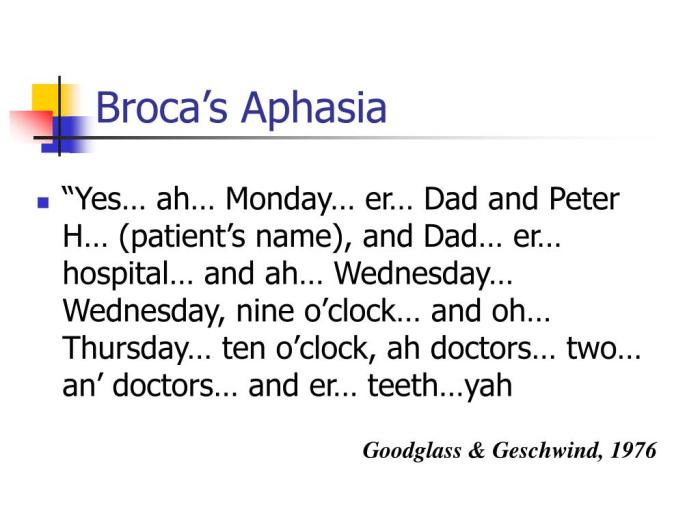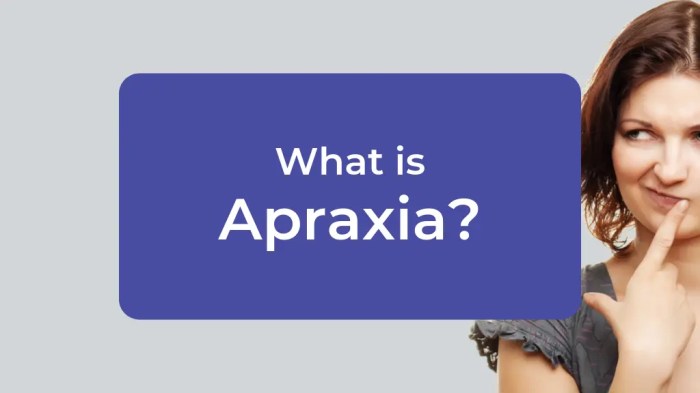What is brocas aphasia – What is Broca’s aphasia? This neurological condition impacts a person’s ability to produce speech, significantly impacting their communication. Understanding its causes, symptoms, and treatment options is crucial for supporting those affected and learning about the human brain’s intricate language networks. This exploration delves into the specifics of this challenging condition, revealing the impact on both spoken and written language, and highlighting the diagnostic process and available treatments.
Broca’s aphasia, a type of expressive aphasia, stems from damage to Broca’s area in the frontal lobe of the brain. This damage hinders the ability to formulate and articulate thoughts into coherent speech. While comprehension might remain relatively intact, individuals struggle to produce fluent and grammatically correct sentences. The difficulty extends to written language as well, impacting the ability to express oneself through writing.
Defining Broca’s Aphasia
Broca’s aphasia, a type of expressive aphasia, is a language disorder that primarily affects the ability to produce language. It’s characterized by significant difficulties in speaking, writing, and sometimes even understanding certain aspects of language, particularly when those aspects involve complex grammar. Understanding this disorder is crucial for recognizing and treating individuals affected by stroke or other neurological conditions.Broca’s aphasia results from damage to a specific area in the brain, critical for language production.
This damage often arises from strokes, head injuries, or other neurological conditions.
Anatomical Location
The affected brain region in Broca’s aphasia is located in the frontal lobe, in the left hemisphere of the brain. This region, known as Broca’s area, is crucial for the motor planning and execution of speech. Damage to this area disrupts the connection between the brain’s language centers and the muscles involved in speech production. This disruption leads to the characteristic symptoms of Broca’s aphasia.
Typical Symptoms
Individuals with Broca’s aphasia typically experience significant difficulty in producing fluent and grammatically correct speech. Their speech may be slow, effortful, and often consists of short, fragmented phrases. They might struggle to find the right words, use telegraphic speech (omitting grammatical elements like articles, prepositions), and have trouble repeating words or phrases. In addition to difficulties with spoken language, writing is also often impaired, exhibiting similar characteristics of slowness, fragmentation, and grammatical errors.
These difficulties with both spoken and written language can range in severity depending on the extent of the brain damage. A person with Broca’s aphasia may still have a relatively good understanding of language, although understanding complex sentences might be challenging.
Comparison to Other Aphasia Types
| Feature | Broca’s Aphasia | Wernicke’s Aphasia |
|---|---|---|
| Speech Production | Impaired; slow, effortful, telegraphic | Relatively intact; fluent but often nonsensical |
| Comprehension | Relatively intact; difficulty understanding complex sentences | Impaired; difficulty understanding spoken and written language |
| Other symptoms | Aggravation in expressing needs, frustration; difficulty repeating words or phrases; struggles with writing; potential for difficulty in understanding complex sentences. | Difficulty with naming objects; often unaware of language errors; difficulty in comprehending speech and written language; may exhibit word salad (a jumble of unconnected words). |
This table highlights the key differences between Broca’s aphasia and Wernicke’s aphasia, emphasizing the contrasting effects on speech production and comprehension. Understanding these distinctions is essential for accurate diagnosis and tailored treatment approaches.
Understanding the Impact on Communication
Broca’s aphasia, a type of expressive aphasia, significantly impacts an individual’s ability to communicate. It’s a condition that affects the brain’s ability to produce language, leading to difficulties in both spoken and written expression. While comprehension remains relatively intact, the challenges in expressing thoughts and ideas can be profoundly isolating and impact daily life.The impact of Broca’s aphasia extends beyond simple word-finding problems; it profoundly affects how individuals interact socially and navigate everyday situations.
The frustration and emotional toll of struggling to communicate effectively are significant aspects of the condition, requiring empathy and understanding from those around them.
Broca’s aphasia, a fascinating neurological condition, impacts a person’s ability to produce speech fluently. While seemingly unrelated, understanding how this language impairment affects the brain might actually shed light on other complex medical issues, like renal cell carcinoma. For example, learning about the symptoms, causes, diagnosis, and treatment options for renal cell carcinoma can offer a more holistic view of the intricacies of the human body and the challenges of medical diagnostics.
renal cell carcinoma symptoms causes diagnosis and treatment Ultimately, delving into the complexities of Broca’s aphasia reveals how intricately connected our cognitive functions are.
Spoken Language Production Difficulties
The core issue in Broca’s aphasia lies in the struggle to produce fluent, grammatically correct speech. Individuals may understand what they want to say but find it hard to articulate the words. This often results in halting speech, with pauses and repetitions, and a reliance on simple sentence structures. They may also omit grammatical elements like prepositions or conjunctions.
Challenges in Daily Communication
The everyday interactions of individuals with Broca’s aphasia can be fraught with challenges. Conversations may feel strained as they struggle to express their thoughts clearly. Simple requests or responses can take considerable effort, leading to frustration for both the speaker and the listener. Understanding non-verbal cues can be vital in these situations, and patience and active listening are essential for effective communication.
Misunderstandings are more likely to occur due to the difficulty in expressing nuances of meaning or context.
Impact on Written Language Production
The difficulties observed in spoken language extend to written communication. Individuals with Broca’s aphasia face challenges in composing coherent and grammatically correct written text. Their writing may be characterized by short, simple sentences, missing words, and grammatical errors. The struggle to form complete thoughts and express them in writing is a significant obstacle in academic, professional, and personal settings.
Common Difficulties in Social Interactions
Social interactions become significantly challenging for individuals with Broca’s aphasia. They might struggle to participate in conversations, express their feelings, or maintain social relationships. Simple requests, like ordering food or asking for directions, can become complex and time-consuming tasks. The emotional burden of not being able to express themselves clearly or be understood can be substantial.
Broca’s aphasia, a fascinating language disorder, impacts a person’s ability to produce speech fluently. While the exact causes are complex, sometimes a similar frustrating issue can be a terribly itchy scalp. Fortunately, various treatments for itchy scalps are available, ranging from medicated shampoos to home remedies like apple cider vinegar rinses. Knowing how itchy scalp is treated how itchy scalp is treated might not directly address the neurological intricacies of Broca’s aphasia, but understanding the range of possible treatments for similar frustrating issues is always valuable.
Ultimately, Broca’s aphasia is a complex condition requiring professional medical attention, and understanding its various aspects is crucial.
Table of Specific Communication Problems
| Category | Problem Description | Example |
|---|---|---|
| Spoken Language | Difficulty forming complete sentences, frequent pauses, and repetitions. | Struggling to say “I went to the store to buy bread,” instead saying “store… bread… go.” |
| Written Language | Difficulty writing coherent sentences, omitting words, and grammatical errors. | Writing “went store buy bread” instead of “I went to the store to buy bread.” |
Diagnostic Considerations
Diagnosing Broca’s aphasia requires a multi-faceted approach, combining careful neurological evaluations with sophisticated neuroimaging techniques and standardized language assessments. The process aims to pinpoint the location and extent of brain damage responsible for the communication difficulties, ultimately guiding treatment and management strategies. A thorough understanding of the patient’s symptoms and history is crucial for accurate diagnosis.Precise identification of Broca’s aphasia is essential for developing an effective treatment plan.
This involves not only recognizing the characteristic language deficits but also determining the underlying neurological cause and its impact on other cognitive functions. The diagnostic process should include a comprehensive assessment of the patient’s language abilities, cognitive skills, and neurological status.
Neuroimaging Techniques
Neuroimaging plays a critical role in confirming the presence of brain damage and identifying its location. These techniques provide valuable insights into the structural and functional aspects of the brain, aiding in the localization of the affected area. Different neuroimaging modalities are employed, each offering specific information about the brain.
Broca’s aphasia is basically a language impairment affecting speech production. It’s fascinating how different neurological conditions can affect communication, like how cherry angiomas, which are those little red spots, can sometimes show up in various parts of the body. Learning about these conditions helps us understand the complexities of the human brain and body even more. For a deeper dive into cherry angioma symptoms, causes, diagnosis, and treatment, check out this resource: cherry angioma symptoms causes diagnosis treatment.
Ultimately, understanding Broca’s aphasia requires exploring the intricate pathways of language processing in the brain.
- Magnetic Resonance Imaging (MRI): MRI provides detailed anatomical images of the brain, allowing for visualization of any structural abnormalities, such as lesions or tumors, that might be contributing to the aphasia. High-resolution images can highlight subtle differences in brain tissue, aiding in the localization of damage. For instance, a focal lesion in Broca’s area on an MRI scan would strongly suggest a possible diagnosis of Broca’s aphasia.
- Functional Magnetic Resonance Imaging (fMRI): fMRI assesses brain activity by detecting changes in blood flow. By comparing brain activity during language tasks with activity during baseline conditions, fMRI can pinpoint areas of the brain involved in language processing. If a patient demonstrates reduced activity in Broca’s area during language tasks, this would be consistent with the characteristics of Broca’s aphasia.
Language Assessments
Comprehensive language assessments are indispensable for evaluating the specific nature and severity of the communication impairments. These assessments help quantify the extent of the language deficit and differentiate Broca’s aphasia from other types of aphasia or cognitive impairments. The assessments often include standardized tests.
- Speech and Language Assessments: Standardized tests of language function, such as the Boston Diagnostic Aphasia Examination (BDAE), are used to assess various aspects of language, including fluency, comprehension, repetition, and naming. These assessments provide quantitative data, enabling clinicians to compare the patient’s performance with normative data and establish a baseline for progress monitoring.
- Informal Conversational Assessments: Beyond standardized tests, informal conversational assessments provide insights into the patient’s ability to use language in natural contexts. These assessments allow for evaluation of the patient’s spontaneous speech, ability to maintain a conversation, and overall communication effectiveness. This approach complements standardized assessments by offering a more dynamic view of the patient’s communication abilities.
Specific Tests and Procedures
Various specific tests and procedures are employed during the diagnostic process. These are crucial in identifying the specific characteristics of the aphasia. The specific tests used will depend on the particular patient and the clinical setting.
- Neurological Examination: A thorough neurological examination, including assessing cranial nerves, motor functions, and sensory functions, is crucial to rule out other neurological conditions that might mimic Broca’s aphasia.
- Cognitive Assessments: Alongside language assessments, cognitive tests are administered to evaluate other cognitive functions, such as attention, memory, and executive functions. This is vital to differentiate Broca’s aphasia from other cognitive disorders that may affect communication.
Diagnostic Tools
The following table Artikels some of the key diagnostic tools used in assessing Broca’s aphasia.
| Tool | Description |
|---|---|
| MRI | Provides detailed anatomical images of the brain, identifying structural abnormalities. |
| fMRI | Assesses brain activity during language tasks, pinpointing areas of reduced activity. |
| Language tests (e.g., BDAE) | Standardized tests to quantify language deficits in fluency, comprehension, repetition, and naming. |
Treatment Approaches: What Is Brocas Aphasia
Recovering from Broca’s aphasia is a multifaceted journey, and treatment approaches are tailored to each individual’s unique needs and progress. Effective treatment plans often combine various strategies to stimulate language recovery and improve communication skills. The goal is to maximize the individual’s ability to express themselves and understand others.While complete recovery is not always possible, many individuals with Broca’s aphasia experience significant improvements in their communication abilities through dedicated therapy and support.
Speech-Language Therapy, What is brocas aphasia
Speech-language therapy plays a pivotal role in the treatment of Broca’s aphasia. It is a personalized, dynamic process that addresses the specific language deficits of each patient. Therapy focuses on improving both receptive and expressive language skills.
- Principles of Therapy: Speech-language therapy for Broca’s aphasia is guided by principles that aim to re-establish neural pathways and enhance communication. These principles include:
- Repetition and Practice: Consistent repetition of targeted language elements, including words, phrases, and sentences, is crucial for strengthening neural connections and improving fluency.
- Gradual Progression: Therapy progresses from simple to complex tasks, building upon previously acquired skills.
- Focus on Context: Therapeutic activities are often embedded in real-life contexts to facilitate meaningful communication.
- Multimodal Approaches: Combining different communication methods, such as gestures, pictures, and writing, can help compensate for language limitations.
- Therapeutic Exercises: A range of exercises are employed to target specific language deficits. These exercises can include:
- Naming objects: Patients are prompted to name various objects, gradually increasing the complexity of the names.
- Sentence construction: Patients are guided through constructing simple sentences, progressing to more complex grammatical structures.
- Reading aloud: This exercise helps to strengthen the link between written words and spoken language.
- Following instructions: Tasks are designed to improve the patient’s understanding and ability to follow complex instructions.
- Conversation practice: Structured conversations are utilized to simulate real-life communication scenarios.
Medications
Medications are generally not a primary treatment for Broca’s aphasia. While medications may be used to address underlying medical conditions that might contribute to the aphasia, they do not directly target the language impairment itself.
Other Treatment Approaches
Other approaches may be explored in conjunction with speech-language therapy. These might include:
- Augmentative and Alternative Communication (AAC) techniques: These techniques employ visual aids, gestures, or other methods to facilitate communication when spoken language is severely impaired. AAC aids can be very helpful for those with limited speech production.
- Assistive technology: Assistive technology tools, such as speech-generating devices, can aid in communication and provide alternative means of expression.
Effectiveness of Treatment Approaches
| Approach | Description | Effectiveness |
|---|---|---|
| Speech therapy | Personalized therapy focusing on language skills, including expressive and receptive language, and utilizing repetition and context. | Generally highly effective, with significant improvements often observed in communication skills. Individual responses vary. |
| Medications | Medication is not a direct treatment for Broca’s aphasia, but may be used to address underlying medical conditions. | Limited effectiveness on the language impairment itself. |
| AAC and assistive technology | Supports communication through visual aids, gestures, or speech-generating devices. | Highly effective in supporting communication when spoken language is severely limited. Can improve quality of life. |
Case Studies and Real-World Examples
Understanding Broca’s aphasia through real-world examples is crucial for comprehending the complexities of this condition and the potential for successful interventions. These accounts highlight the challenges faced by individuals, the innovative treatment approaches, and the pivotal role of support systems in their recovery journey. They also illuminate the diverse ways communication can be adapted and improved.
A Case Study of Mr. Hernandez
Mr. Hernandez, a 55-year-old former accountant, experienced a stroke that severely impacted his expressive language abilities. His diagnosis confirmed Broca’s aphasia. Initially, his speech was severely limited, primarily to short, fragmented phrases, and often grammatically incorrect. He struggled to articulate his needs, and simple sentences proved challenging.
Symptoms and Diagnosis
Mr. Hernandez’s symptoms manifested as a significant impairment in producing fluent speech. He could understand spoken language to a considerable extent, but formulating his own responses was extremely difficult. His writing abilities were similarly affected. His family reported that he often became frustrated and withdrawn during interactions.
The diagnosis was made through a comprehensive assessment involving language tests, neurological examinations, and imaging scans.
Treatment Approach
Mr. Hernandez’s treatment focused on speech therapy, specifically targeted at improving his expressive language skills. He participated in intensive therapy sessions that incorporated various techniques, including:
- Repetition and Reinforcement: The therapist repeatedly modeled correct phrases and sentence structures, encouraging Mr. Hernandez to repeat them. This repetitive practice was a key element in helping him internalize the correct linguistic patterns.
- Visual Aids and Gestures: The therapist used visual aids and gestures to facilitate communication and comprehension, helping him bridge the gap between his thoughts and spoken words. Visual cues allowed him to express his thoughts more effectively.
- Alternative Communication Methods: Augmentative and alternative communication (AAC) strategies, like picture boards and speech-generating devices, were introduced to compensate for his speech limitations. This provided him with immediate tools to express himself, fostering independence and confidence.
Outcomes and Impact on Life
Mr. Hernandez’s progress was gradual but significant. After several months of dedicated therapy, he demonstrated improved articulation and sentence construction. He started using more complex phrases and expressing his needs more clearly. The introduction of AAC devices empowered him to participate more actively in conversations and daily activities.
His family reported a marked improvement in his overall mood and social engagement. His ability to communicate more effectively reduced feelings of isolation and frustration.
Real-World Examples (Potential Scenarios)
| Patient Demographics | Symptoms and Diagnosis | Treatment Approach | Outcomes and Impact on Life |
|---|---|---|---|
| A 62-year-old retired teacher | Difficulty forming complete sentences, primarily affecting spoken language; comprehension remains relatively intact. | Intensive speech therapy focused on sentence structure and vocabulary building; use of visual aids and gestures; introduction of a speech-generating device. | Improved communication skills, enabling more effective participation in social interactions; increased confidence and self-esteem. |
| A 38-year-old software engineer | Significant difficulty in expressing thoughts through spoken language, impacting professional communication; some impairment in writing skills. | Speech therapy emphasizing vocabulary expansion and sentence complexity; incorporation of computer-based language exercises; focus on functional communication. | Improved professional communication skills, leading to increased job satisfaction and opportunities; reduced frustration and increased self-efficacy. |
Illustrative Information

Delving into the complexities of Broca’s aphasia requires understanding the specific brain regions involved. This section will provide detailed descriptions of the crucial anatomical structures and their relationship to the communication deficits. Visual representations, though not actual images, will aid in comprehending the locations of these areas.The intricate network of neurons and pathways within the brain is essential for fluent language production.
Damage to specific areas can lead to the characteristic symptoms of Broca’s aphasia, highlighting the critical interplay between anatomy and function.
Brain Structures Relevant to Broca’s Aphasia
Understanding the precise location of the damage is crucial for diagnosing and treating Broca’s aphasia. The affected areas are not isolated but rather form a connected network. The key structures include:
- Broca’s Area: Located in the inferior frontal gyrus of the dominant hemisphere (typically the left), Broca’s area is primarily responsible for the planning and production of speech. It coordinates the motor commands needed to articulate words. Damage to this area significantly impacts the ability to produce fluent and grammatically correct speech.
- Frontal Lobe: The frontal lobe encompasses Broca’s area and is involved in higher-level cognitive functions like planning, problem-solving, and voluntary movement. The frontal lobe’s role in language production extends beyond Broca’s area, as evidenced by the wider range of deficits observed in patients with more extensive frontal damage.
- Motor Cortex: Situated in the frontal lobe, the motor cortex is crucial for controlling voluntary movements. The motor cortex’s connection to Broca’s area underscores the direct link between the brain’s planning of speech and the physical act of speaking. Damage can result in difficulty with articulation, even when the individual understands the intended message.
Visual Representation (Conceptual)
Imagine a simplified model of the human brain, highlighting the left hemisphere. Within this hemisphere, a small region, Broca’s area, is depicted. It is situated near the frontal lobe, adjacent to the motor cortex. A visual cue, like a highlighted or shaded area, would illustrate this specific region. Surrounding this region, the frontal lobe would be indicated as a larger area, emphasizing its broader involvement in cognitive functions.
The motor cortex, adjacent to Broca’s area, is also visually highlighted to showcase its direct connection with speech production.
Detailed Description of the Illustration
The conceptual visualization of the brain would clearly identify Broca’s area as a crucial component of the language production system. The adjacent frontal lobe and motor cortex would be showcased as integral parts of the network involved in the planning and execution of speech. The shaded or highlighted regions emphasize the specific areas of the brain implicated in Broca’s aphasia.
“Damage to Broca’s area and its associated structures within the frontal lobe, coupled with disruptions in the neural pathways linking these areas, directly underlies the language production deficits observed in Broca’s aphasia.”
Outcome Summary

In conclusion, Broca’s aphasia presents a complex challenge to communication and daily life. While the condition can significantly impact language production, both spoken and written, early diagnosis and appropriate treatment, particularly speech therapy, can help improve communication skills and quality of life. Understanding the neurological basis and the variety of treatment approaches is essential for supporting those affected by this condition.
Ultimately, compassion, patience, and access to the right resources are key to helping individuals with Broca’s aphasia navigate their communication challenges effectively.




